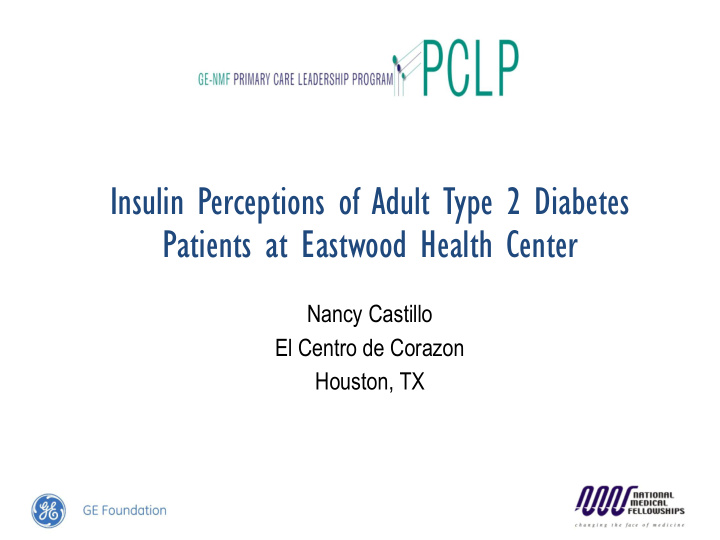



Insulin Perceptions of Adult Type 2 Diabetes Patients at Eastwood Health Center Nancy Castillo El Centro de Corazon Houston, TX
Introduction • CDC: 29.1 million people with diabetes in US • Texas: 1.8 million adults have diabetes • High prevalence in underserved populations 11.0% of adult Hispanic population in Texas has diabetes • El Centro del Corazon: • 93.1% of patient population Latino • 9.6% of adult patient population has diabetes • Purpose: understand the perceived barriers to insulin use
Background • Type 2 diabetes • Risk factors and complications • Lowering HbA1c levels reduces risk for complications • Treatment: lifestyle factors (exercise, diet), oral hypoglycemics, INSULIN • Insulin • Resistance by patients • Wounderberg, Lucas, Latour, and Scholte op Reimer (2011) reported that 50% of patients whose next step was insulin did not start treatment until 5 years after developing complications • “Psychological insulin resistance” (PIR)
Methodology • Cross-sectional pilot study x3 weeks • Setting: Eastwood Health Center • Sample: Type 2 diabetes adult patients • Measure: “Insulin Perceptions Questionnaire” • Self-administered • Qualitative and quantitative questions • Procedure: Questionnaire distributed by medical assistants and front desk clerks • Statistical analysis: SPSS
Results • Quantitative Data: • Statistically Significant Data: Questions 1, 8, 14, and 17 • Spanish speakers: • higher positive insulin benefits perception • English speakers: • more strongly agreed that the use of insulin could lead to worse health status • insulin would make lives less flexible (statistically significant) • Negative correlation between the perceived benefits of insulin to the fears/discomforts and others perceptions • Qualitative Data: • Spanish respondents: concerns regarding weight gain, fetal deformity, and future need for dialysis
Discussion • Lack of reported HbA1c levels • No link between acculturation and perceived insulin benefits • Negative correlation between perceived insulin benefits to perceived fears/discomfort and others perceptions • Limitations: • small sample size, disproportionately greater Spanish speaking group, literacy levels, monitor for completeness of survey • Future Research: • Repeat study in larger sample size, assess other demographic variables like income and highest level of education
Recommendations • Address PIR at an individual level • Ask about fears/concerns • Education (insulin benefits)… • Clarify misconceptions • Videos while in waiting room, pamphlets, diabetes education class • Significance of HbA1c • Introduce insulin early, before patient needs it
Conclusion • Diabetes is an important and prevalent issue • Improve education • Understanding • Insulin perceptions • Prevent complications • Approach at personal level
Acknowledgements • Medical Director: Dr. Kavon Young • Nurse Manager: Ana Perez • Medical assistants, front desk clerks, and all staff at Eastwood Health Center • Faculty Advisor: Dr. Denise Neill
References • Berkowitz, A. (2007). Clinical Pathophysiology Made Ridiculously Simple. Miami, FL: Med Master Inc. p. 107-109. • Centers for Disease Control and Prevention (2014). National Diabetes Statistics Report: Estimates of Diabetes Burden in the United States, 2014. Atlanta, GA: U.S. Department of Health and Human Services. • Machinani, S., Bazargan-Hejazi, S., & Hsia, S. H. (2013). Psychological insulin resistance among low-income, U.S. racial minority patients with type 2 diabetes. Primary Care Diabetes, 7(1): 51-55. doi:10.1016/j.pcd.2012.11.003 • MedlinePlus (2014). A1c Test. Retrieved August 23, 2014 from: http://www.nlm.nih.gov/medlineplus/ency/article/003640.htm • Rubino, A., McQuay, L.J., Gough, S.C., Kvasz, M., & Tennis, P. (2007). Delayed initiation of subcutaneous insulin therapy after failure of oral glucose- lowering agents in patients with Type 2 diabetes: a population-based analysis in the UK. Diabetic Medicine, 24(12): 1412-1418. • Texas Department of State Health Services (2012). Texas Diabetes Prevention and Control Program, Diabetes Status in Texas, 2012 . Retrived August 23, 2014 from: http://www.dshs.state.tx.us/diabetes/tdcdata.shtm • Woundenberg, Y.J.C, Lucas, C., Latour, C., & Scholte op Reimer, W.J.M. (2012). Acceptance of insulin therapy: a long shot? Insulin resistance in primary care. Diabetec Medicine, 29(6): 796-802. doi: 10.1111/j.1464- 5491.2011.03552.x
Recommend
More recommend